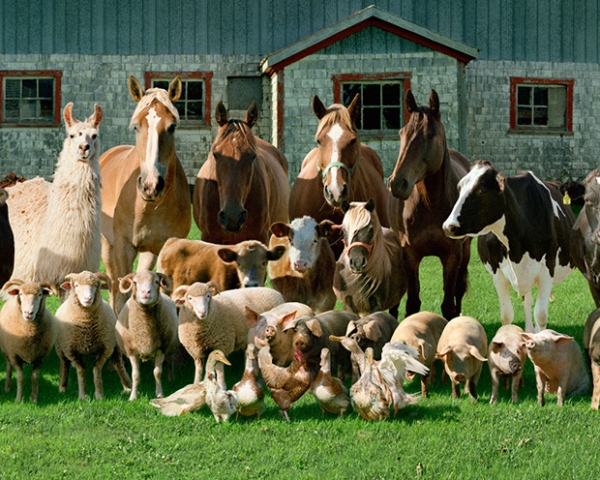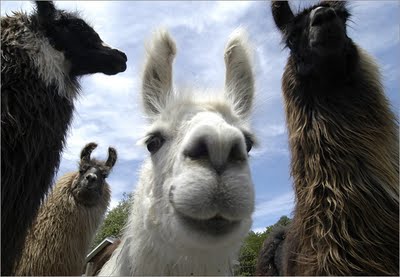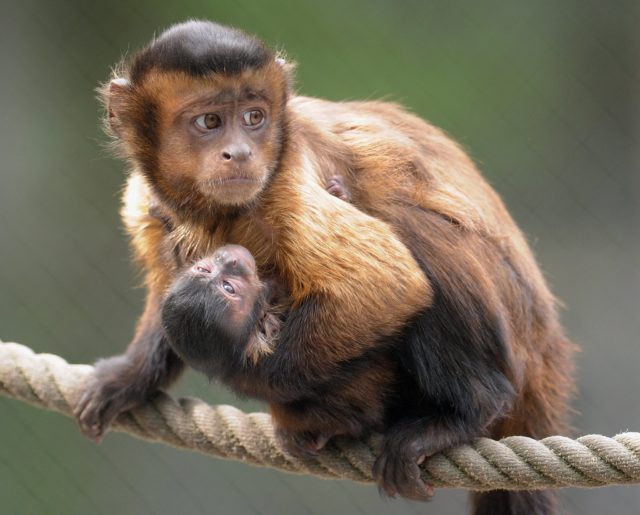https://ift.tt/1LD0t2i
Whether they are our next-door neighbors or the animals at the zoo (or those neighbors with kids that belong in a zoo), everyone has a place of origin and a story of how they got to where they are now. Too often, we assume one’s background by where they live and their present status. However, even in the animal world, that can be misleading. Here are some common animals that have a natural history that you may not have expected.
10. Livestock animals
Despite greasy burgers becoming a staple in the Western diet, many don’t think of where the animals in our food came from before being the trademark of North American farms. In 1492, Christopher Columbus discovered the New World in an event that became known as the Spanish Conquest. Many people then moved to the Americas for a new life. However, they also needed a food source that they knew was reliable. Settlers brought along hundreds of animals and plants between the late 1400s and the early 1600s. This became known as the Columbian Exchange. These animals include the cattle, sheep, pigs, and horses that we mostly associate with the prairies and farmlands of North America. None of these species were from the Americas, and as an unfortunate consequence they also brought along diseases. One such disease was small pox. Despite the loss of life, the animals continued to be used by both settlers and natives because most North American animals were hard to tame.
9. Horses
Most equestrian fanatics like to argue that horses were from Europe because they were part of the Columbian Exchange in the 1600s. However, the fossil record shows that the earliest members of the Equus genus, which also includes zebras and donkeys, existed in North America four million years ago. By one or two million years later, the famed Bering Strait that separates modern Russia and the state of Alaska was instead a land bridge of ice formed during the last Ice Age. This bridge gave the ancestors of horses a way of entering Asia, where they spread and eventually reached Europe. Then they returned full circle to North America as domestic animals.
Some equestrian ancestors remained in North America but died out 13,000 to 11,000 years ago. It seems that most of North America is unaware of this, since government institutions claim that horses are non-native.
8. Eastern North American lizards
While horses left North America for a new life in Eurasia, many reptilian species decided to take a road trip (or rather an ice trip) over the Bering land bridge into the New World. In fact, this happened three times during the Miocene epoch, around 20 million years earlier than the migration of the early equestrians.
What is interesting is that many of these lizards exist today in eastern North America, an entire continent across from the Bering Strait. Eleven eastern North American lizard species are of Eurasian origin, with seven species of skinks and four glass lizards. Three more species from that area came from present-day Central America, including an iguana, a whiptail, and a spiny lizard species. Those fourteen species account for more than 80% of lizards living east of the Mississippi River.
Additionally, nearly 30% of frog species in that area also have roots across the Bering Strait.
7. Gray wolves
When we think of the Canadian or American wilderness, often what comes to mind are those fluffy, sharp-toothed relatives of our canine house pets called wolves. We all remember that time when Fido ran away from home for a day or two and then came back, wagging tail and all, right? Well this may be a genetic coincidence, Fido’s ancestors may have been native to North America, but escaped into Eurasia via the Bering Strait before separating into different species. One such species is the gray wolf, Canis lupus, that began two million years ago.
Canis lupus then split into three subspecies: the Mexican wolf, the Great Plains or buffalo wolf, and the most common Northwestern wolf. After spelunking for lemmings and deer in Eurasia for a quarter million years, the gray wolf decided to return back to its homeland on the other side of the Bering land bridge. This occurred over three separate invasions for each subspecies, the Mexican wolf being first and the northwestern subspecies last (it looks like even Mother Nature couldn’t escape the rule of threes).
6. Caviomorphs
Caviomorpha is a group of rodents that include the capybara, porcupine, chinchilla, paca, and guinea pig. Most people recognize that these animals are found in South America, but many mistakenly believe that they originated from there. A study from 1994 examined fossils of early South American caviomorphs and extinct African rodents called phiomorphs (e.g. the naked mole rat). Scientists found similarities in teeth structure that suggest an African ancestry for South American rodents.
The most supported theory of how the caviomorphs came to South America is waif dispersal, which is biology-speak for hitch-hiking on rafts. This is estimated to have occurred around thirty to forty million years ago, when the continents of Africa and South America were closer together. At that time the rodents only needed to travel about 1700 kilometers rather than the present 9800 kilometers. This can be further supported by the fact that there is also a family of porcupines in Africa, no doubt a result of evolutionary divergence.
5. Llamas/alpacas
We all love those goofy looking, buck-toothed woolly animals that we see at petting zoos. Often they are also on postcards and calendar pictures of the world-famous Machu Picchu in Peru. But what if we told you those spit-firing animals were actually from North America? Up until three million years ago, South American animals evolved independently from all the other continents due to geological isolation (except for our Africa-based caviomorph friends, of course). Then the Earth’s crust rose, exposing the connection between North and South America known as Panama. This allowed for the Great American Interchange, a broad-scale swapping of animals between the two continents. The llamas and alpacas were among those to travel from North to South America.
In fact, almost half of the animals present in South America in modern times are of North American origin. The success of the northerners may have been a consequence of sharing borders with Asian, European, and African animals before continental drift split them apart. This made the North American species tougher competition against the southern natives.
4. Raccoons
According to common knowledge, raccoons are native to North America. This is supported by the fact that every North American has had to clean up after these rascals every time they decided to destroy garbage bags for last dinner’s scraps. Contrary to common knowledge, raccoons actually originated from South America as part of the family Procyonidae. They were one of the few groups to travel to North America during the Great American Interchange via the Panamian land bridge, opposite to the llamas that left the north to check out the Mayan ruins (who would blame them?).
A few species of raccoons still live in South America after three million years, as well as their relatives, the coati and kinkajou. Between the spitting projectiles and constant humming of alpacas versus the thievery and mischief of raccoons, we’d say it was a fair trade.
3. New World monkeys
What is unique about the New World monkeys of South America is their prehensile tails, which are the only monkey tails in the world that can grip onto branches for extended periods of time. Some species included in this group are tamarins, howler monkeys, and capuchins (a favorite in box office movies – Night at the Museum, anyone?) Some believe that these monkeys were also immigrants from North America as part of the Great American Interchange.
However, fossil examinations from 2003 and 2015 showed that they have little in common with any endemic American primate or monkey fossils, but they do have similarities with African species. Scientists are not sure how it happened, but they can estimate that the African ancestors reached South American shores at least 26 million years ago. It is possible that they were rafting buddies with the African rodents (imagine having to sleep next to those porcupines, ouch).
2. African felines
It is ironic that lions and leopards are part of the African Big Five, considering their roots are not African. Until 15 million years ago, Africa and Eurasia were separated by the Tethys Sea. Continental drift eventually brought the two closer together, shrinking the Tethys Sea into what is now known as the Mediterranean. Through island hopping, many species were then able to cross from Eurasia into Africa and spread, with big cats being among them.
The proof presented itself in 2010, when palaeontologists discovered a four million-year-old feline skull in Tibet, naming it the earliest big cat in the fossil record. This suggested that lions and leopards are actually of Asian origin, along with all other felines. Researchers estimate that felines began separating into different species as early as 16 million years ago. This sudden speciation may have been because of gradual increases in altitude that occurred in the Tibetan Plateau.
1. Humans
Yes, even the history of our race is up for debate. Common knowledge states that humanity began in Africa and then eventually spread to the rest of the world. This, to all intents and purposes, is true. However, humanity in this instance is synonymous with our species Homo sapiens, not with all hominids (human-like beings). Ancient fossils found in Spain suggest that hominids may have originated from Eurasia, and then traveled back to Africa after the Tethys Sea shrank.
But, looking even further into the past, their ancestors were apes that originated in Africa but left for Eurasia opposite the lions, 14 or 15 million years ago, when the Tethys Sea first disappeared. In essence, our ancestors got kicked out of the house for a few years in hope of a new life only to come back home broke and live in Mom’s basement (sound familiar? Maybe it’s evolutionary).
AMAZING
TRENDS,AMAZING
via Toptenz.net http://www.toptenz.net
May 14, 2018 at 06:23AM
.png)











No comments:
Post a Comment